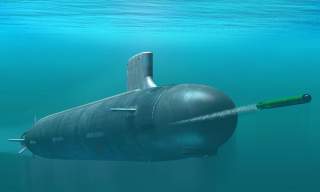The Navy's Best Submarine Is Getting a Big Boost in Firepower
Thanks to more cruise missiles.
The idea is to have additional Tomahawk or other missile capabilities on the attack submarines increased by 2026, when the “SSGN” Ohio-Class Guided Missile Submarines start retiring in larger numbers. While designed primarily to hold Tomahawks, the VPM missile tubes are engineered such that they could accommodate a new payload, new missile or even a large unmanned underwater vehicle, Navy officials said.
The Navy has begun early “tube and hull” forging of new missile tubes for its fleet of Block V Virginia-Class attack submarines as part of a plan to massively increase undersea firepower and provide commanders with a wider range of attack options.
For Virginia-class Block V construction, the Navy is planning to insert a new 84-foot long section designed to house additional missile capability - “Virginia Payload Modules.”
The Virginia Payload Modules, slated to become operational by the 2020s, will increase the Tomahawk missile firepower of the submarines from 12 missiles up to 40, Navy weapons developers explain.
Recommended: Stealth vs. North Korea’s Air Defenses: Who Wins?
Recommended: America’s Battleships Went to War Against North Korea
Recommended: 5 Places World War III Could Start in 2018
“Early construction of Virginia Payload Modules, is underway,” Naval Sea Systems Command spokesman Bill Couch told Warrior Maven.
The Navy recently awarded General Dynamics subsidiary Electric Boat a nearly $700 million deal to start long-lead items acquisition for the Block V Virginia-class boats.
Production of the tubes follows extensive planning and prototyping efforts in recent years.
“Tube and Hull” forging is a key step in the construction of submarine-launched weapons by merging missile tubes into a base-structure in blocks – which are then inserted into “modules” for the boat. While a similar technique is now also underway with the Columbia-Class submarines, Couch explained that the process and configuration is proceeding differently for Virginia-class subs.
The VPM submarines will have an additional (approximately 84 feet) section with four additional Virginia Payload Tubes (VPTs), each capable of carrying seven Tomahawk cruise missiles, for a ship total of 40 Tomahawks.
The idea is to have additional Tomahawk or other missile capabilities on the attack submarines increased by 2026, when the “SSGN” Ohio-Class Guided Missile Submarines start retiring in larger numbers.
While designed primarily to hold Tomahawks, the VPM missile tubes are engineered such that they could accommodate a new payload, new missile or even a large unmanned underwater vehicle, Navy officials said.
The reason for the Virginia Payload Modules is clear; beginning in the 2020s, the Navy will start retiring four large Ohio-class guided-missile submarines able to fire up to 154 Tomahawk missiles each. This will result in the Navy losing a massive amount of undersea fire power capability, Navy officials explained.
From 2002 to 2008 the U.S. Navy modified four of its oldest nuclear-armed Ohio-class submarines by turning them into ships armed with only conventional missiles -- the USS Ohio, USS Michigan, USS Florida and USS Georgia. They are called SSGNs, with the “G” designation for “guided missile.”
Virginia-Class subs are fast-attack submarines armed with Tomahawk missiles, torpedoes and other weapons able to perform a range of missions; these include anti-submarine warfare, strike warfare, covert mine warfare, ISR (Intelligence, Surveillance, Reconnaissance), anti-surface/ship warfare and naval special warfare, something described as having the ability to carry and insert Special Operations Forces.
Future Virginia-Class submarines (VCS) provide improved littoral (coastal waters) capabilities, sensors, special operations force employment, and strike warfare capabilities, making it an ideal platform for the 21st Century security environment, Navy developers said.
Compared to prior Navy attack subs like the Los Angeles-Class, the Virginia-Class submarines are engineered to bring vastly improved littoral warfare, surveillance and open ocean capabilities, service officials said.
For instance, the ships can be driven primarily through software code and electronics, thus freeing up time and energy for an operator who does not need to manually control each small maneuver.
The Block III Virginia-Class submarines have what’s called a Large Aperture Bow conformal array sonar system – designed to send out an acoustic ping, analyze the return signal, and provide the location and possible contours of enemy ships, submarines and other threats. Al Virginia-Class boats will have this moving forward.
The Virginia-Class submarine are engineered with this “Fly-by-Wire” capability which allows the ship to quietly linger in shallow waters without having to surface or have each small move controlled by a human operator. With this technology, a human operator will order depth and speed, allowing software to direct the movement of the planes and rudder to maintain course and depth.
Also, unlike their predecessor-subs, Virginia-Class subs are engineered with what’s called a “Lock Out Trunk” – a compartment in the sub which allows special operations forces to submerge beneath the water and deploy without requiring the ship to surface.
This first appeared in Warrior Maven here.

